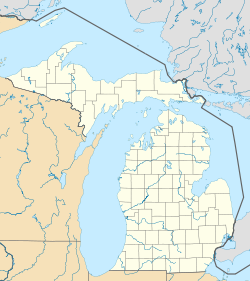Mellus Newspapers Building | |
Formerly listed on the U.S. National Register of Historic Places | |
 Former site of building | |
 Interactive map | |
| Location | 1661 Fort St., Lincoln Park, Michigan |
|---|---|
| Coordinates | 42°15′6″N83°10′31″W / 42.25167°N 83.17528°W |
| Area | less than one acre |
| Built | 1941 |
| Architectural style | Moderne |
| Demolished | 2010 |
| NRHP reference No. | 05000716 [1] |
| Significant dates | |
| Added to NRHP | July 20, 2005 |
| Removed from NRHP | July 24, 2024 |
The Mellus Newspapers Building was a commercial building at 1661 Fort Street in Lincoln Park, Michigan. It was listed on the National Register of Historic Places in 2005, [1] and demolished in 2010. [2] The building was removed from the National Register of Historic Places in 2024. [3]



